Ukrainian vs Dutch Community Comparison
COMPARE
Ukrainian
Dutch
Social Comparison
Social Comparison
Ukrainians
Dutch
8,528
SOCIAL INDEX
82.8/ 100
SOCIAL RATING
66th/ 347
SOCIAL RANK
6,444
SOCIAL INDEX
61.9/ 100
SOCIAL RATING
155th/ 347
SOCIAL RANK
Dutch Integration in Ukrainian Communities
The statistical analysis conducted on geographies consisting of 442,770,850 people shows a strong positive correlation between the proportion of Dutch within Ukrainian communities in the United States with a correlation coefficient (R) of 0.714. On average, for every 1% (one percent) increase in Ukrainians within a typical geography, there is an increase of 0.239% in Dutch. To illustrate, in a geography comprising of 100,000 individuals, a rise of 1,000 Ukrainians corresponds to an increase of 238.9 Dutch.
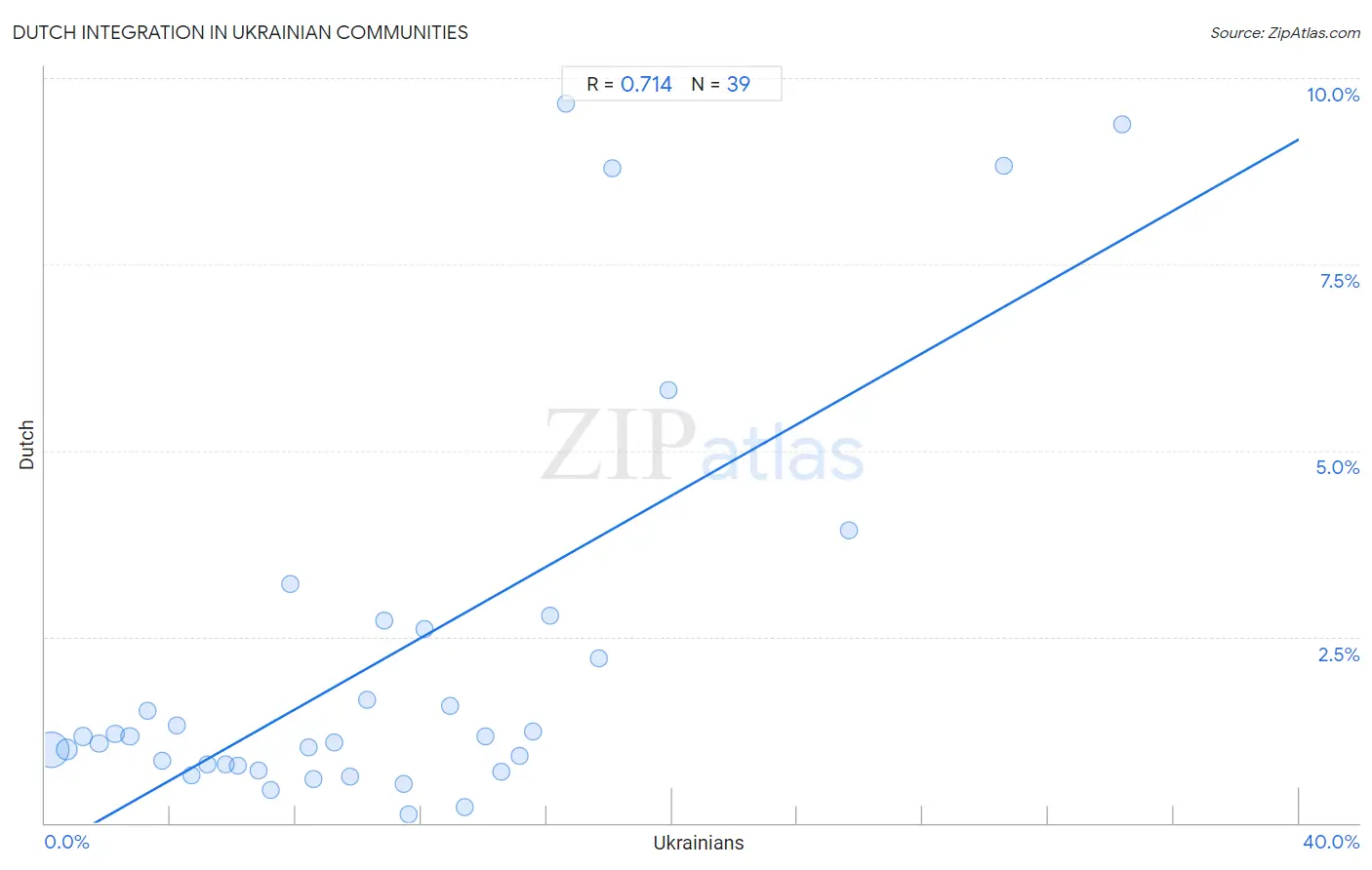
Ukrainian vs Dutch Income
When considering income, the most significant differences between Ukrainian and Dutch communities in the United States are seen in per capita income ($48,014 compared to $42,605, a difference of 12.7%), median female earnings ($42,015 compared to $37,339, a difference of 12.5%), and median earnings ($50,320 compared to $45,370, a difference of 10.9%). Conversely, both communities are more comparable in terms of householder income under 25 years ($53,843 compared to $51,265, a difference of 5.0%), householder income over 65 years ($63,032 compared to $59,539, a difference of 5.9%), and wage/income gap (27.3% compared to 29.6%, a difference of 8.5%).

| Income Metric | Ukrainian | Dutch |
| Per Capita Income | Exceptional $48,014 | Fair $42,605 |
| Median Family Income | Exceptional $111,368 | Fair $101,192 |
| Median Household Income | Exceptional $91,456 | Fair $82,971 |
| Median Earnings | Exceptional $50,320 | Poor $45,370 |
| Median Male Earnings | Exceptional $59,728 | Average $54,410 |
| Median Female Earnings | Exceptional $42,015 | Tragic $37,339 |
| Householder Age | Under 25 years | Exceptional $53,843 | Tragic $51,265 |
| Householder Age | 25 - 44 years | Exceptional $102,451 | Fair $93,081 |
| Householder Age | 45 - 64 years | Exceptional $108,475 | Average $99,650 |
| Householder Age | Over 65 years | Excellent $63,032 | Poor $59,539 |
| Wage/Income Gap | Tragic 27.3% | Tragic 29.6% |
Ukrainian vs Dutch Poverty
When considering poverty, the most significant differences between Ukrainian and Dutch communities in the United States are seen in single male poverty (12.6% compared to 14.1%, a difference of 12.1%), seniors poverty over the age of 75 (11.7% compared to 10.5%, a difference of 11.4%), and single female poverty (19.8% compared to 22.0%, a difference of 11.1%). Conversely, both communities are more comparable in terms of family poverty (7.9% compared to 7.8%, a difference of 0.63%), male poverty (10.1% compared to 10.2%, a difference of 1.0%), and poverty (11.2% compared to 11.3%, a difference of 1.1%).
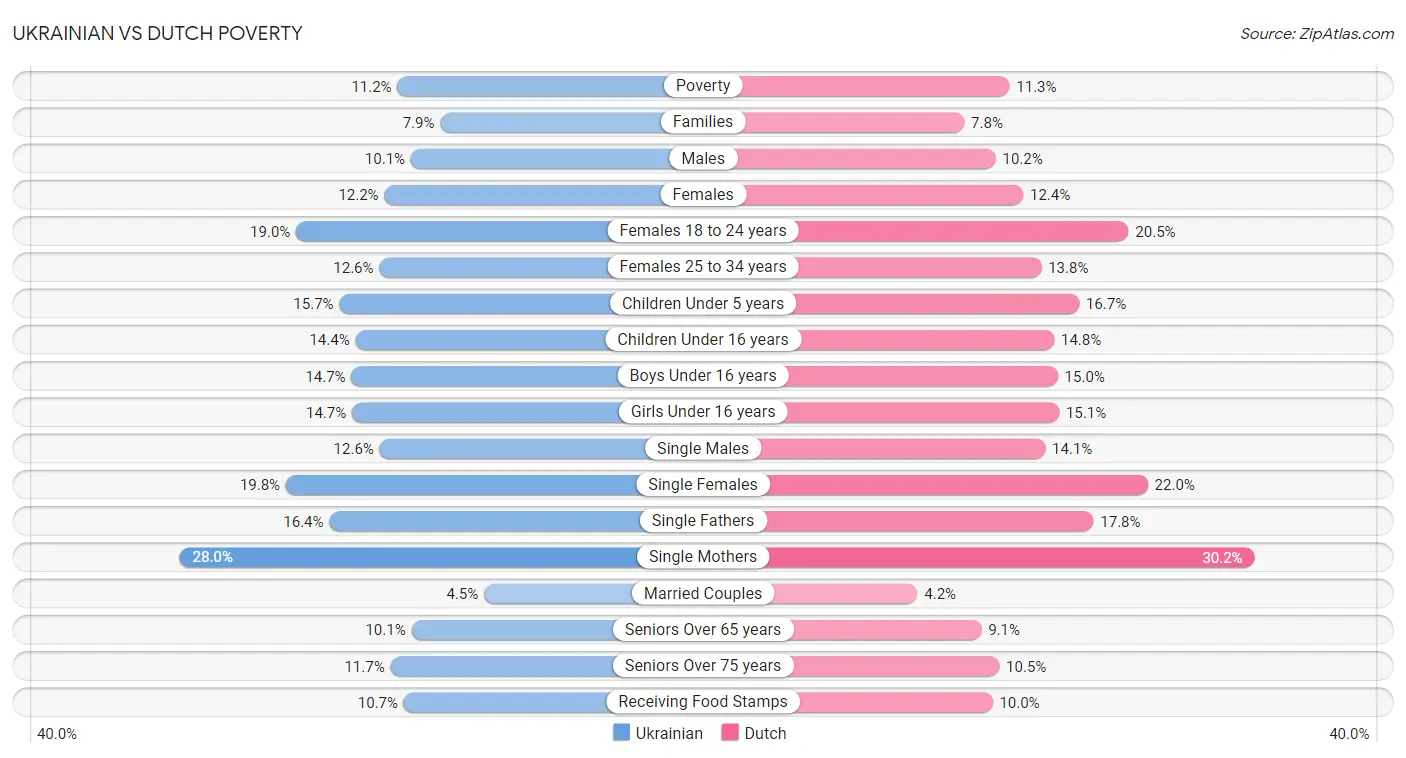
| Poverty Metric | Ukrainian | Dutch |
| Poverty | Exceptional 11.2% | Exceptional 11.3% |
| Families | Exceptional 7.9% | Exceptional 7.8% |
| Males | Exceptional 10.1% | Exceptional 10.2% |
| Females | Exceptional 12.2% | Exceptional 12.4% |
| Females 18 to 24 years | Exceptional 19.0% | Poor 20.5% |
| Females 25 to 34 years | Exceptional 12.6% | Fair 13.8% |
| Children Under 5 years | Exceptional 15.7% | Good 16.7% |
| Children Under 16 years | Exceptional 14.4% | Exceptional 14.8% |
| Boys Under 16 years | Exceptional 14.7% | Exceptional 15.0% |
| Girls Under 16 years | Exceptional 14.7% | Exceptional 15.1% |
| Single Males | Excellent 12.6% | Tragic 14.1% |
| Single Females | Exceptional 19.8% | Tragic 22.0% |
| Single Fathers | Fair 16.4% | Tragic 17.8% |
| Single Mothers | Exceptional 28.0% | Tragic 30.2% |
| Married Couples | Exceptional 4.5% | Exceptional 4.2% |
| Seniors Over 65 years | Exceptional 10.1% | Exceptional 9.1% |
| Seniors Over 75 years | Excellent 11.7% | Exceptional 10.5% |
| Receiving Food Stamps | Exceptional 10.7% | Exceptional 10.0% |
Ukrainian vs Dutch Unemployment
When considering unemployment, the most significant differences between Ukrainian and Dutch communities in the United States are seen in unemployment among seniors over 75 years (9.3% compared to 10.4%, a difference of 11.8%), unemployment among women with children under 6 years (7.4% compared to 8.1%, a difference of 9.7%), and unemployment among ages 16 to 19 years (17.5% compared to 15.9%, a difference of 9.7%). Conversely, both communities are more comparable in terms of unemployment among seniors over 65 years (5.1% compared to 5.1%, a difference of 0.22%), unemployment among ages 65 to 74 years (5.3% compared to 5.3%, a difference of 0.49%), and unemployment among ages 25 to 29 years (6.6% compared to 6.5%, a difference of 1.2%).
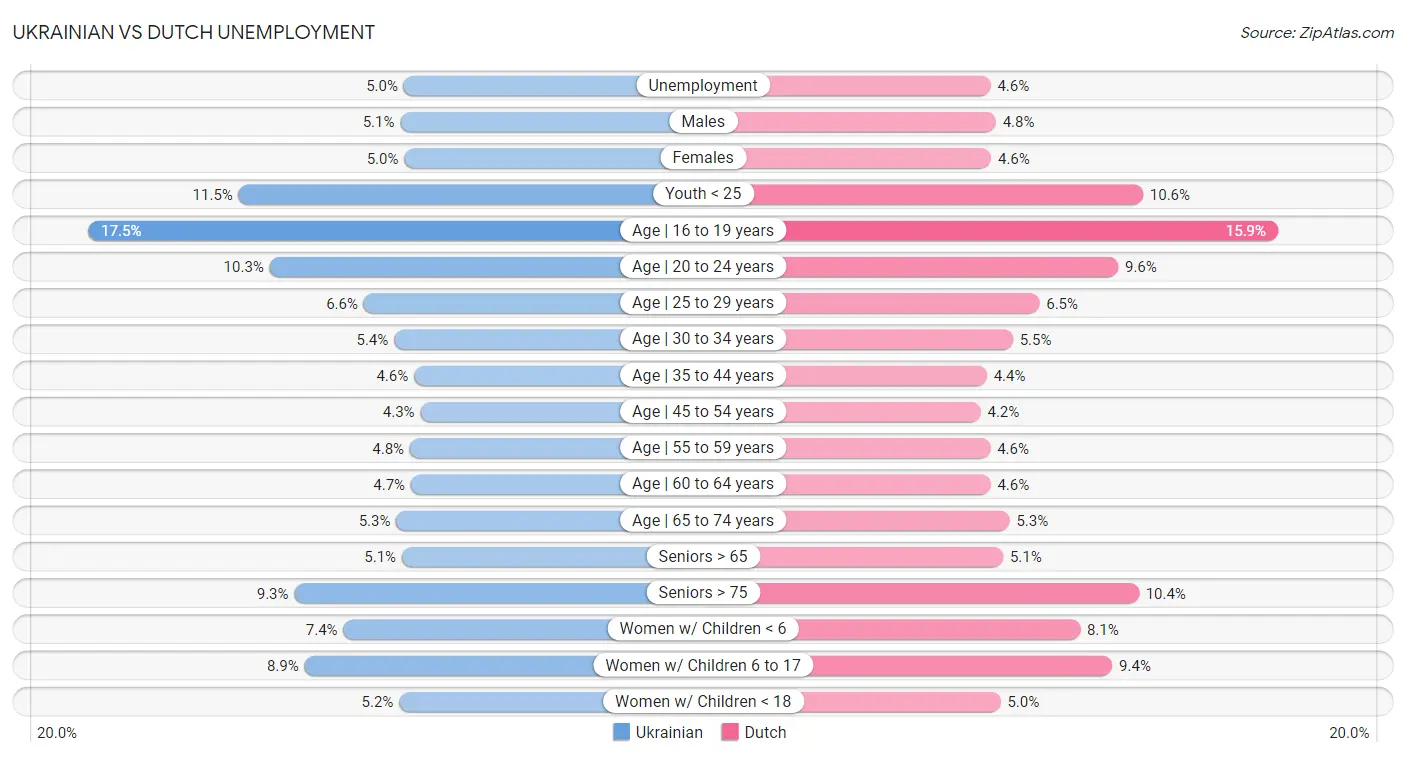
| Unemployment Metric | Ukrainian | Dutch |
| Unemployment | Exceptional 5.0% | Exceptional 4.6% |
| Males | Excellent 5.1% | Exceptional 4.8% |
| Females | Exceptional 5.0% | Exceptional 4.6% |
| Youth < 25 | Good 11.5% | Exceptional 10.6% |
| Age | 16 to 19 years | Good 17.5% | Exceptional 15.9% |
| Age | 20 to 24 years | Average 10.3% | Exceptional 9.6% |
| Age | 25 to 29 years | Good 6.6% | Excellent 6.5% |
| Age | 30 to 34 years | Good 5.4% | Average 5.5% |
| Age | 35 to 44 years | Good 4.6% | Exceptional 4.4% |
| Age | 45 to 54 years | Exceptional 4.3% | Exceptional 4.2% |
| Age | 55 to 59 years | Good 4.8% | Exceptional 4.6% |
| Age | 60 to 64 years | Exceptional 4.7% | Exceptional 4.6% |
| Age | 65 to 74 years | Excellent 5.3% | Good 5.3% |
| Seniors > 65 | Excellent 5.1% | Excellent 5.1% |
| Seniors > 75 | Tragic 9.3% | Tragic 10.4% |
| Women w/ Children < 6 | Excellent 7.4% | Tragic 8.1% |
| Women w/ Children 6 to 17 | Average 8.9% | Tragic 9.4% |
| Women w/ Children < 18 | Exceptional 5.2% | Exceptional 5.0% |
Ukrainian vs Dutch Labor Participation
When considering labor participation, the most significant differences between Ukrainian and Dutch communities in the United States are seen in in labor force | age 16-19 (38.3% compared to 43.8%, a difference of 14.5%), in labor force | age 20-24 (75.9% compared to 78.4%, a difference of 3.3%), and in labor force | age > 16 (64.9% compared to 64.2%, a difference of 1.1%). Conversely, both communities are more comparable in terms of in labor force | age 25-29 (85.2% compared to 84.9%, a difference of 0.30%), in labor force | age 45-54 (83.2% compared to 82.8%, a difference of 0.45%), and in labor force | age 35-44 (84.7% compared to 84.3%, a difference of 0.53%).

| Labor Participation Metric | Ukrainian | Dutch |
| In Labor Force | Age > 16 | Poor 64.9% | Tragic 64.2% |
| In Labor Force | Age 20-64 | Excellent 79.9% | Fair 79.3% |
| In Labor Force | Age 16-19 | Exceptional 38.3% | Exceptional 43.8% |
| In Labor Force | Age 20-24 | Exceptional 75.9% | Exceptional 78.4% |
| In Labor Force | Age 25-29 | Exceptional 85.2% | Excellent 84.9% |
| In Labor Force | Age 30-34 | Exceptional 85.2% | Fair 84.5% |
| In Labor Force | Age 35-44 | Exceptional 84.7% | Fair 84.3% |
| In Labor Force | Age 45-54 | Exceptional 83.2% | Good 82.8% |
Ukrainian vs Dutch Family Structure
When considering family structure, the most significant differences between Ukrainian and Dutch communities in the United States are seen in single father households (2.1% compared to 2.4%, a difference of 13.7%), births to unmarried women (29.2% compared to 31.5%, a difference of 7.8%), and divorced or separated (11.8% compared to 12.4%, a difference of 5.3%). Conversely, both communities are more comparable in terms of average family size (3.14 compared to 3.11, a difference of 0.95%), family households (64.2% compared to 64.9%, a difference of 1.2%), and family households with children (26.9% compared to 27.4%, a difference of 1.7%).

| Family Structure Metric | Ukrainian | Dutch |
| Family Households | Fair 64.2% | Exceptional 64.9% |
| Family Households with Children | Tragic 26.9% | Fair 27.4% |
| Married-couple Households | Exceptional 48.1% | Exceptional 49.5% |
| Average Family Size | Tragic 3.14 | Tragic 3.11 |
| Single Father Households | Exceptional 2.1% | Poor 2.4% |
| Single Mother Households | Exceptional 5.7% | Exceptional 5.8% |
| Currently Married | Exceptional 48.4% | Exceptional 49.6% |
| Divorced or Separated | Exceptional 11.8% | Tragic 12.4% |
| Births to Unmarried Women | Exceptional 29.2% | Average 31.5% |
Ukrainian vs Dutch Vehicle Availability
When considering vehicle availability, the most significant differences between Ukrainian and Dutch communities in the United States are seen in no vehicles in household (10.7% compared to 6.8%, a difference of 56.9%), 4 or more vehicles in household (6.3% compared to 7.7%, a difference of 21.4%), and 3 or more vehicles in household (19.6% compared to 22.9%, a difference of 16.8%). Conversely, both communities are more comparable in terms of 1 or more vehicles in household (89.6% compared to 93.3%, a difference of 4.1%), 2 or more vehicles in household (55.8% compared to 61.6%, a difference of 10.4%), and 3 or more vehicles in household (19.6% compared to 22.9%, a difference of 16.8%).

| Vehicle Availability Metric | Ukrainian | Dutch |
| No Vehicles Available | Fair 10.7% | Exceptional 6.8% |
| 1+ Vehicles Available | Average 89.6% | Exceptional 93.3% |
| 2+ Vehicles Available | Good 55.8% | Exceptional 61.6% |
| 3+ Vehicles Available | Average 19.6% | Exceptional 22.9% |
| 4+ Vehicles Available | Average 6.3% | Exceptional 7.7% |
Ukrainian vs Dutch Education Level
When considering education level, the most significant differences between Ukrainian and Dutch communities in the United States are seen in professional degree (5.1% compared to 4.0%, a difference of 25.7%), no schooling completed (1.8% compared to 1.4%, a difference of 22.8%), and master's degree (16.9% compared to 13.8%, a difference of 22.2%). Conversely, both communities are more comparable in terms of 12th grade, no diploma (92.7% compared to 92.9%, a difference of 0.19%), ged/equivalency (87.7% compared to 87.5%, a difference of 0.25%), and nursery school (98.3% compared to 98.7%, a difference of 0.35%).
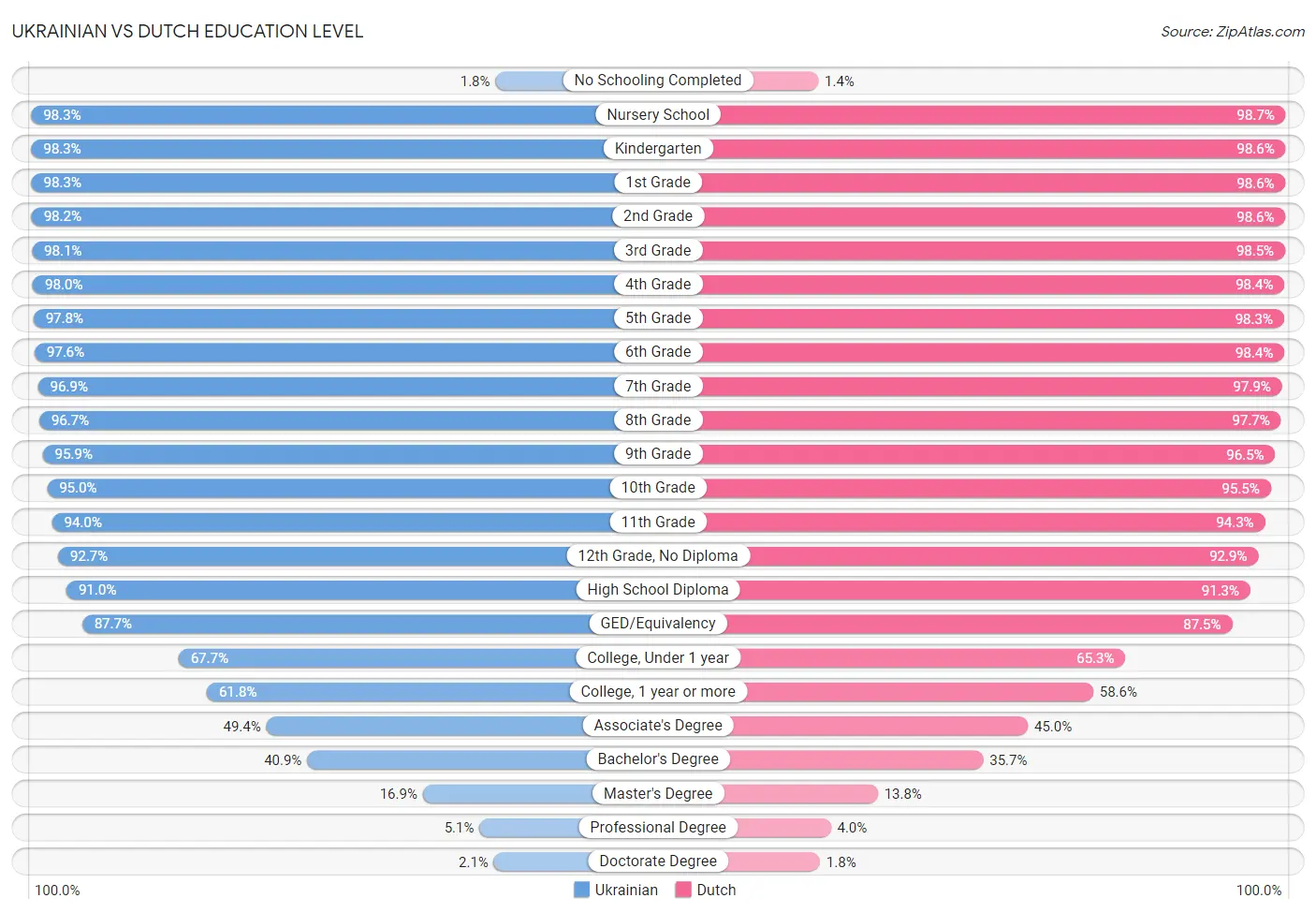
| Education Level Metric | Ukrainian | Dutch |
| No Schooling Completed | Exceptional 1.8% | Exceptional 1.4% |
| Nursery School | Exceptional 98.3% | Exceptional 98.7% |
| Kindergarten | Exceptional 98.3% | Exceptional 98.6% |
| 1st Grade | Exceptional 98.3% | Exceptional 98.6% |
| 2nd Grade | Exceptional 98.2% | Exceptional 98.6% |
| 3rd Grade | Exceptional 98.1% | Exceptional 98.5% |
| 4th Grade | Exceptional 98.0% | Exceptional 98.4% |
| 5th Grade | Exceptional 97.8% | Exceptional 98.3% |
| 6th Grade | Exceptional 97.6% | Exceptional 98.4% |
| 7th Grade | Exceptional 96.9% | Exceptional 97.9% |
| 8th Grade | Exceptional 96.7% | Exceptional 97.7% |
| 9th Grade | Exceptional 95.9% | Exceptional 96.5% |
| 10th Grade | Exceptional 95.0% | Exceptional 95.5% |
| 11th Grade | Exceptional 94.0% | Exceptional 94.3% |
| 12th Grade, No Diploma | Exceptional 92.7% | Exceptional 92.9% |
| High School Diploma | Exceptional 91.0% | Exceptional 91.3% |
| GED/Equivalency | Exceptional 87.7% | Exceptional 87.5% |
| College, Under 1 year | Exceptional 67.7% | Average 65.3% |
| College, 1 year or more | Exceptional 61.8% | Fair 58.6% |
| Associate's Degree | Exceptional 49.4% | Poor 45.0% |
| Bachelor's Degree | Exceptional 40.9% | Tragic 35.7% |
| Master's Degree | Exceptional 16.9% | Tragic 13.8% |
| Professional Degree | Exceptional 5.1% | Tragic 4.0% |
| Doctorate Degree | Exceptional 2.1% | Fair 1.8% |
Ukrainian vs Dutch Disability
When considering disability, the most significant differences between Ukrainian and Dutch communities in the United States are seen in disability age under 5 (1.3% compared to 1.7%, a difference of 28.6%), hearing disability (3.2% compared to 3.7%, a difference of 15.3%), and disability age 35 to 64 (11.0% compared to 12.3%, a difference of 12.2%). Conversely, both communities are more comparable in terms of disability age over 75 (46.4% compared to 46.5%, a difference of 0.21%), cognitive disability (16.6% compared to 16.8%, a difference of 0.72%), and self-care disability (2.5% compared to 2.4%, a difference of 3.1%).
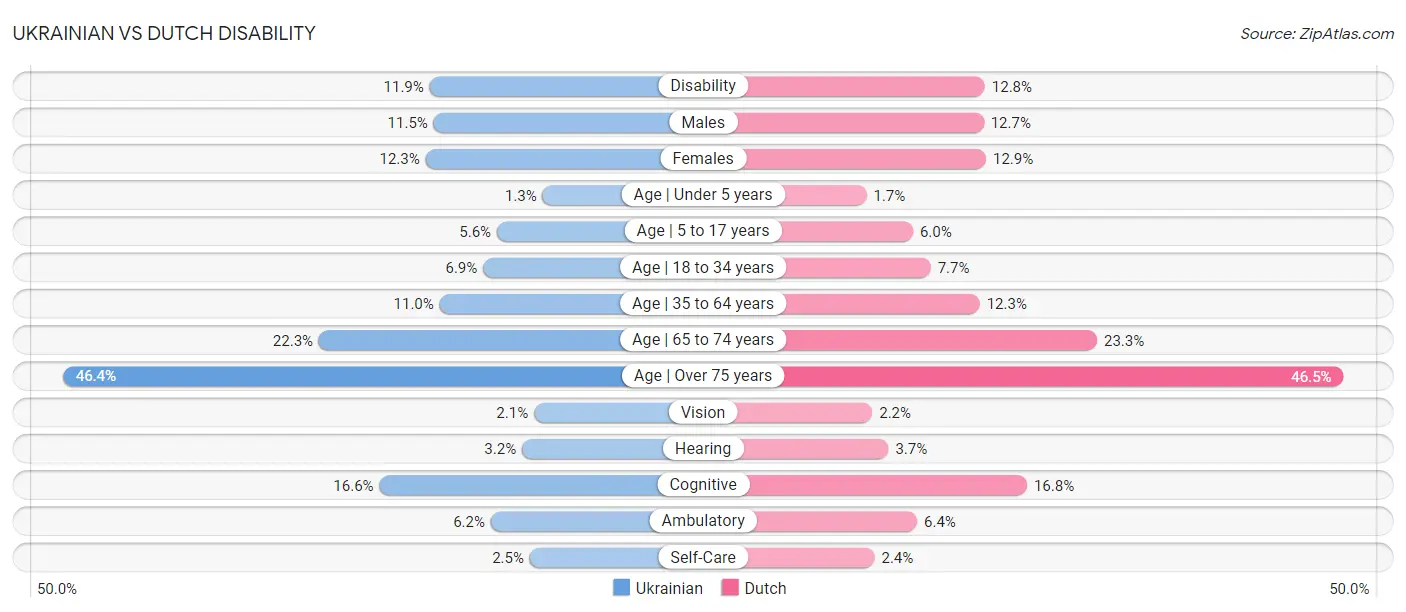
| Disability Metric | Ukrainian | Dutch |
| Disability | Poor 11.9% | Tragic 12.8% |
| Males | Poor 11.5% | Tragic 12.7% |
| Females | Fair 12.3% | Tragic 12.9% |
| Age | Under 5 years | Tragic 1.3% | Tragic 1.7% |
| Age | 5 to 17 years | Average 5.6% | Tragic 6.0% |
| Age | 18 to 34 years | Tragic 6.9% | Tragic 7.7% |
| Age | 35 to 64 years | Good 11.0% | Tragic 12.3% |
| Age | 65 to 74 years | Exceptional 22.3% | Average 23.3% |
| Age | Over 75 years | Exceptional 46.4% | Exceptional 46.5% |
| Vision | Excellent 2.1% | Poor 2.2% |
| Hearing | Tragic 3.2% | Tragic 3.7% |
| Cognitive | Exceptional 16.6% | Exceptional 16.8% |
| Ambulatory | Fair 6.2% | Tragic 6.4% |
| Self-Care | Fair 2.5% | Good 2.4% |